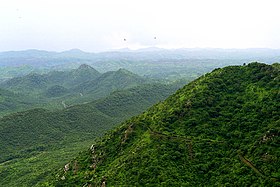Aravalli Mountains
| Aravalli Range | |
|---|---|

The Aravali Range in Rajasthan
|
|
| Highest point | |
| Peak | Guru Shikhar, Mount Abu |
| Elevation | 1,722 m (5,650 ft) |
| Coordinates | 24°35′33″N 74°42′30″E / 24.59250°N 74.70833°E |
| Dimensions | |
| Length | 692 km (430 mi) |
| Naming | |
| Pronunciation | Hindustani pronunciation: [ aa ra vli] |
| Geography | |
| Country |
|
| States | Rajasthan, Haryana, Delhi and Gujarat |
| Region | North India, Western India |
| Settlement | Delhi, Gurugram, Mount Abu |
| Range coordinates | 25°00′N 73°30′E / 25°N 73.5°ECoordinates: 25°00′N 73°30′E / 25°N 73.5°E |
| Rivers | Banas, Luni, Sakhi and Sabarmati |
| Geology | |
| Orogeny | Aravalli-Delhi Orogen |
| Age of rock | Precambrian |
| Type of rock | Fold mountains from Plate tectonics |
The Aravalli Range is a range of mountains running approximately 692 km (430 mi) in a northwest direction, starting in North India from Delhi and passing through southern Haryana, through to Western India across the states of Rajasthan and ending in Gujarat.
Aravalli, a composite Sanskrit word from "ara" and "vali", literally means the "line of peaks".
The Aravalli Range, an eroded stub of ancient mountains, is the oldest range of fold mountains in India. The natural history of the Aravalli Range dates back to a pre-Indian subcontinental collision with the mainland Eurasian Plate. The Proterozoic Aravalli-Delhi orogenic belt in north west India is similar to the younger Himalayan-type orogenic belts of the Mesozoic-Cenozoic era (of the Phanerozoic) in terms of component parts and appears to have passed through a near-orderly Wilson supercontinental cycle of events. The range rose in a Precambrian event called the Aravalli-Delhi Orogen. The Aravalli Range is a northeast-southwest trending orogenic belt that is located in the northwestern part of Indian Peninsula. It is part of the Indian Shield that was formed from a series of cratonic collisions. In ancient times, Aravalli were extremely high but since have worn down almost completely by millions of years of weathering, where as the Himalayas being young fold mountains are still continuously rising. Aravalli, being the old fold mountains, have stopped growing higher due to the cessation of upward thrust caused by the stopping of movement of the tectonic plates in the Earth's crust below them. The Aravalli Range joins two of the ancient earth's crust segments that make up the greater Indian craton, the Aravalli Craton which is the Marwar segment of earths crust to the northwest of the Aravalli Range, and the Bundelkand Craton segment of earths crust to the southeast of the Aravalli Range. Cratons, generally found in the interiors of tectonic plates, are old and stable parts of the continental lithosphere that has remained relatively undeformed during the cycles of merging and rifting of continents.
...
Wikipedia

